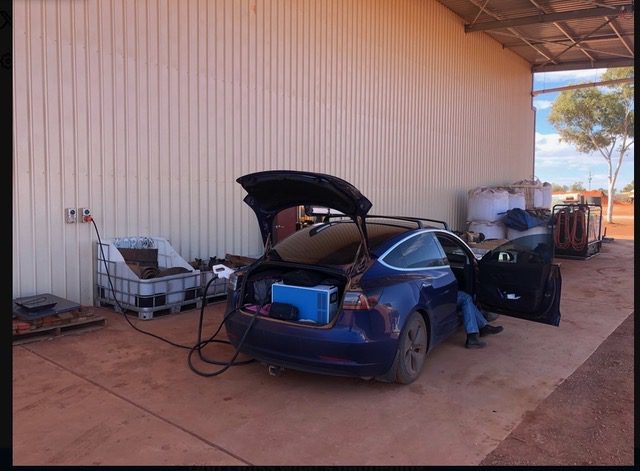The Great Central Road runs 1,126 km from Yulara in the Northern Territory to Laverton in Western Australia, and it is considered to be one of Australia’s iconic great drives.
It’s unsealed with a reputation for bad corrugations, potholes, bull dust and sandy sections, so most travel sites still recommend 4WD, while noting that it is possible in 2WD.
I recently caught up with Rod Dilkes, from Margaret River in WA, who prefers adventurous holidays and included this route in his last trip from home, up to the top of WA then down the middle of NT to the start at Yulara earlier this month, accompanied at various times by his partner, sister and an old friend for the desert crossing.
Rod drives a slightly unusual 2019 variant of Tesla Model 3, a long range AWD Performance with standard rather than sports suspension, giving about 120mm clearance. The car has done 120,000 km and has a highway range of around 320km at 110kph, running on 18 inch wheels shod with mid-range Toyo tyres.
After several trials he managed to fit in an Engel fridge, two spare tyres (one half sized), two tents, a 20 litre water container, personal luggage and a bulky AC to DC rectifier for 19kW DC charging from 32A 3 phase AC points. Quite amazing.
The driving itself was relatively straightforward, with about half the route being suitable for 80-90kph and the rest for 60-70kph, apart from the worst stretch into Laverton.
At one point the corrugations transmitted through the steering wheel were so bad that Rod’s sports watch rewarded him for reaching his 10,000 step target. Despite being heavily laden the car had sufficient clearance, was very smooth on corrugations and always felt stable with AWD. With a bit of care he managed to avoid both stone chips and flat tyres.
It had not been possible to get in contact with several roadhouses on the route but Rod’s confidence that charging would be available was correct. Plugshare shows nothing from Yulara all the way to Leonora but more of that later.
Day one to Warakurna at 336km was the longest on the route. They arrived with 7% battery remaining to find that a 3 phase plug was out of order but overnight 15A charging at the caravan park was perfectly adequate.
The next day to Warburton was uneventful apart from some difficulty contacting the owner to unlock the roadhouse caravan park. The local mechanic’s 3 phase plug wasn’t earth wired and another in the roadhouse was just out of reach so 15A overnight charging was provided at no extra cost above the camp site, typical of the hospitality along the road.

Tjukayirla roadhouse 247 km on claims to be “the most isolated road house in the world”, and the manager wears a T shirt with this slogan to prove it. He turned out to be a lovely bloke with an interest in EVs and a desire to purchase one when he returned to the city.
He also volunteered that no other EV had ever come through in his time. Rod would not wish to lay claim to this, but it is likely that he is the first to do this road in an EV, hence no Plugshare entries. In celebration, the manager announced that charging (again, 15A) would be free for the next ten EVs to come through!
All the road houses are dependent on diesel to function. Tjukayirla uses 2000 litres a week just to keep the lights on. Rod also noted the number of enormous SUV/4WDs on the road and how much diesel they used.
He caught one SUV owner lamenting that – after $300 – the tank still wasn’t full. It wasn’t the moment to mention that the overnight EV charge had been free with the tent site.
Charging at Laverton was arranged through a friend at a 32A plug at a local business, but 15A charging is available at the caravan park, as it is at Leonora back on the bitumen.
The best bit of the trip was meeting friendly, helpful and interested locals. There was genuine interest in EVs, especially around running costs, and none of the usual extension cord jokes.
The trip was not as difficult as Rod expected although rain could render the road impassable. It’s one more hole in the myth that EVs are only for city drivers and can’t be used for remote travel.
A few disclaimers: This is remote country with potentially bad roads, so travel in any vehicle requires careful preparation for all possible emergencies. This includes a means of communication and possibly letting local police know your route. Permits for travel through indigenous lands must be obtained online for no cost, alcohol is prohibited and there is a compulsory fruit and vegetable quarantine point at the border.

